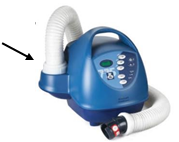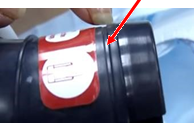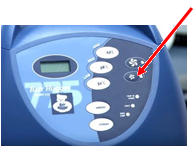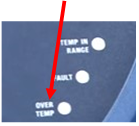Managing body temperature: using a forced air warming device – 3M Bair Hugger® 775
exp date isn't null, but text field is
Objectives
Forced air warming blankets are a commonly used medical device in the perioperative setting and within Paediatric Intensive Care and High Dependency units They are used as a means of preventing inadvertent hypothermia during prolonged operative procedures, and to help establish and maintain normothermia in acutely and critically ill infants and children.
Scope
This nursing procedural guideline is intended to be followed by nurses involved in caring for the highly dependent or critically ill infant or child requiring body temperature management and prevention of hypothermia using forced air warming within the Paediatric Critical Care Unit at RHC (Glasgow).
Audience
All nursing staff involved in the management of body temperature and use of forced air warming in the Paediatric Critical Care Unit should be familiar with this nursing procedural guideline.
|
 |
|
Procedure |
Rationale |
|
Provide age explanation of equipment and procedure to child (and parents) where appropriate. |
To ensure the child (and parents) understand the reason for active warming. |
|
Gather equipment together and wash hands. Don disposable apron. |
To minimise risk of cross infection. |
|
Check that the infant or child’s skin is as dry as possible before putting forced air warming blanket on. |
Air flow over moist skin may cause initial cooling due to evaporation. |
|
Before initiating therapy, check unit is free from any obvious mechanical damage and is safely placed on a hard surface (NOT a bed/mattress*) or securely mounted (Fig1&2)
Fig. 1 |
Injury may result if a faulty unit used or if not secured on stable surface* or secured to pole.
* a bed/mattress surface is uneven and may result in air being blocked and unit to overheat.
|
|
Check unit, ensure the air hose is intact and secure at side port of unit (Fig. 3), then plug in to a properly grounded power source (Do not switch ON yet). |
|
|
Place the Bair Hugger® forced-air blanket (correct size) directly onto the infant or child with the perforated side against the infant or child’s skin (Fig. 4).
Fig. 4 |
Thermal injury may result if any cover or forced-air blanket other than Bair Hugger® used. The slits in the perforated side allow the warm air to surround the infant or child. Placing a blanket or sheet between the infant/child and the forced-air blanket will result in warming being impeded. Placing the plastic cover side of the forced-air blanket instead of the perforated side will impede warming and (if high temperature setting) may even result in skin injury. |
|
Insert the end of the air hose into the cardboard connector (Fig. 5) on the forced-air warming blanket until it fits snugly.
A visual marker (Fig. 6) is located around the mid section of the hose to guide the depth of the hose insertion.
|
Significant thermal injury may occur if the air hose is not attached correctly to the blanket.
Do not "free hose" - i.e. blow warm air onto the infant or child without the blanket being connected.
|
|
Once the Bair Hugger® is on, a cotton blanket or sheet may be placed on top of the forced-air blanket. |
This will help minimize heat loss from the system and keep the forced-air blanket centered on the infant or child. |
|
Press system ON/OFF button to ON. The unit will be in Standby mode and the Standby indicator light (Fig 7. ) will be illuminated. |
 |
|
The 775 unit has two preset fan settings: a default or high fan setting and a reduced or low fan setting.
|
Note: The high fan setting is recommended when placing the Bair Hugger blanket under the infant/child.
Note: Fan setting can be switched from high-low at any time by pressing button. However, these buttons will not place unit into Standby mode. Normally if the blanket is placed on top of the infant/child, the low fan setting should be selected. |
|
Select the desired temperature: E.g. (Fig 9.) High This will turn the blower and heater ON. If the infant/child is pyrexial - temperature can be set to Ambient mode |
Note: It is recommended that caution should be used if selecting a HIGH temperature in those infants or children with impaired circulation. A LOW/MEDIUM (32°C/38°C) setting might be more suitable for those infants or children who are haemodynamically unstable in order to avoid sudden vasodilation and drop in blood pressure. Note: In Ambient mode the heater is inactivated and the unit will supply room temperature air. |
|
When the unit reaches the desired temperature, the "Temp in Range" light will illuminate. (Fig. 10 & 11)
Fig. 11 Note: The Temp in Range light will not illuminate if set in Ambient mode |
 Fig. 10 |
|
Once the Bair Hugger® 775 unit is on and running, a cotton blanket or sheet may be placed on top of the forced-air blanket. |
This will help minimize heat loss from the system and keep the forced-air blanket centered on the infant or child. |
|
Monitor the infant or child’s temperature continually if possible. If not then check temperature and skin frequently (every 20-30mins). Ensure the forced-air blanket is not over the infant or child’s face/head. |
The device can heat the infant or child quite rapidly, therefore frequent temperature and skin checks are necessary to ensure hyperthermia or thermal injury does not occur especially if air hose becomes loose from forced-air blanket connector. In order to reduce the risk of suffocation. Although it is rare, it has also been reported that if the Bair Hugger® blanket is over the face or head and set at HIGH, there may be a risk of thermal softening of the endotracheal tube. |
|
Adjust forced-air temperature or discontinue therapy as required depending upon infant or child’s temperature or clinical condition. |
The device may heat the infant or child quickly, so vital sign instability may occur. If so inform senior nurse and medical staff and reduce air temperature or discontinue therapy. |
|
Warning lights: If overheat warning light (Fig. 12) is illuminated and audible alarm sounds then discontinue therapy immediately.
|
Continuing to use the device when overheating may result in thermal injury. |
|
Discontinuing therapy: When temperature management therapy is complete, press the Standby button (Fig. 13).
Discard disposable components. Disconnect the unit from power source, wipe unit according to local infection control policy and store safely. |
Forced air-warming systems have been in use for a number of years as a means of preventing and treating hypothermia and to provide warmth to cold or shivering patients. Forced-air warming systems such as the Bair Hugger® 775 are routinely used in the perioperative situation, emergency rooms or in critical care units, where hypothermia can complicate treatment and recovery by increasing oxygen demand due to shivering and affect patient coagulation.
The Bair Hugger® 775 may be used in the Paediatric Critical Care Unit for critically ill infants or children who have conditions that may result in an increased risk of hypothermia.
Some studies suggest that forced-air warming, if used correctly, can increase the patient’s core temperature more quickly than other active warming methods, help reduce metabolic energy production and even decrease the requirement for specific cardiovascular drugs.
However, there are limitations in the use of forced-air warming systems such as the Bair Hugger® 775.
The system should not be used over trans-dermal medications as the heat and subsequent vasodilatation of surface blood vessels may result in increased drug uptake.
The warming system should never be used if the infant or child is on intra-aortic balloon pump therapy as thermal injury may occur if heat is applied to ischaemic limbs.
Some studies have suggested that use of forced air warming devices may increase the risk of colonisation with potentially pathogenic organisms. However, other studies have found that there was no increase in bacterial counts.

- 3M Bair Hugger® Model (2017) Temperature management unit Model 775– Operator’s Manual.
- 3M Bair Hugger® Model 775 (2017) Temperature management unit – Information.
- 3M Bair Hugger®Model 775 (2017) Patient Warming with 3M™ Bair Hugger™ Temperature Management Unit 775. (YouTube user video guide)
- Avidan, MS Jones, N Ing, R Khoosal, M Lundgren, C Morrell, DF (1997) Convection warmers – not just hot air. Anaesthesia, Vol. 52 (11), pp 1073-1076.
- Ayala, JL Coe, A (1997) Thermal softening of tracheal tubes: an unrecognised hazard of the Bair Hugger active patient warming system. British Journal of Anaesthesia, Vol. 79, pp 543-545.
- El-Rahmany, HK Steven, FM Schneider, GM El-Gamal, NA Vannier, CA Ammar, R Okasha, AS (2000) Forced air warming decreases vasodilator requirement after coronary artery bypass surgery. Anesthesia & Analgesia, Vol. 90 (2), pp 286-291.
- ECRI (2013) Forced air warming and surgical site infections. Health Devices, April pp. 122-125.
- Frank, SM Fleisher LA Breslow, MJ Higgins, MS Olson, KF Kelly, S Beattie, C (1997) Perioperative maintenance of normothermia reduces the incidence of morbid cardiac events. Journal of the American Medical Association, Vol, 227, pp. 1127-1134.
- Holtzclaw, B (2004) Shivering in acutely ill vulnerable populations. AACN Clinical Issues: Advanced Practice in Acute Critical Care, Vol. 15 (2), pp 267-279.
- Huang, JKC Shah, EF Vinodkumar, N Hegarty, MA Greatorex, RA (2003) The Bair Hugger patient warming system in prolonged vascular surgery: an infection risk? Critical Care, Vol. 7, pp 13-16.
- Kim, P Taghon, t Fetzer, M Tobias, JD (2013) Perioperative hypothermia in the pediatric population: A quality improvement project. American Journal of Medical Quality, Vol. XX (X), pp. 1-7.
- Kongsayreepong, S Gunnaleka, P Suraseranivongse, S Pirayavaraporn, S Chowvanayotin, S Montapaneewat, T Manon, C (2002) A reusable, custom-made warming blanket prevents core hypothermia during major neonatal surgery. Canadian Journal of Anesthetics, Vol. 49 (6), pp 605-609.
- Janke, EL Pilkington, SN Smith, DC (1996) Evaluation of two warming systems after cardiopulmonary bypass. British Journal of Anaesthesia, Vol. 77, pp 268-270.
- McGovern PD, Albrecht M, Belani KG, Nachtsheim C, Partington PF, Carluke I, Reed MR (2011) Forced-air warming and ultra-clean ventilation do not mix: an investigation of theatre ventilation, patient warming and joint replacement infection in orthopaedics. Journal of Bone and Joint Surgery Br., Vol. 93(11):1537-44
- Moola, S Lockwood, C (2011) Effectiveness of strategies for the management and/or prevention of hypothermia within the adult perioperative environment. International Journal of Evidence-based Healthcare, Vol. 9, pp. 337-345.
- Stewart, C Harban, F (2012) Thermal injuries from the use of a forced-air warming device. Pediatric Anesthesia, Vol. 22, pp. 410-419.
- Truell, KD Bakerman, PR Teodori, MF Maze, A (2000) Third degree burns due to intraoperative use of a Bair Hugger warming device. Annals of Thoracic Surgery, Vol. 69 (6), pp 1933-1934.
- Williams, AB Salmon, A Graham, P Galler, D Payton, MJ Bradley, M (2005) Re-warming of healthy volunteers after induced mild hypothermia: a healthy volunteer study. Emergency Medicine, Vol. 22, pp 182-184.
- Witt, L Dennhardt, N Eich, C Mader, T Fischer, T Brauer, A Sumpelmann (2013) Prevention of intraoperative hypothermia in neonates and infants: results of a prospective multicenter observational study with a new forced-air warming system with increased warm air flow. Pediatric Anesthesia, Vol. 23, pp. 469-474.
- Wu, X (2013) The safe and efficient use of forced-air warming systems. AORN Journal, Vol. 97 (3), pp. 302-308.
Last reviewed: 01 July 2017
Next review: 01 July 2019
Author(s): Jeanette Grady, PICU Clinical Nurse Educator
Approved By: PICU Clinical Guideline group



 Fig. 2
Fig. 2

 Fig. 5
Fig. 5 Fig. 6
Fig. 6





 Fig. 12
Fig. 12 Fig. 13
Fig. 13